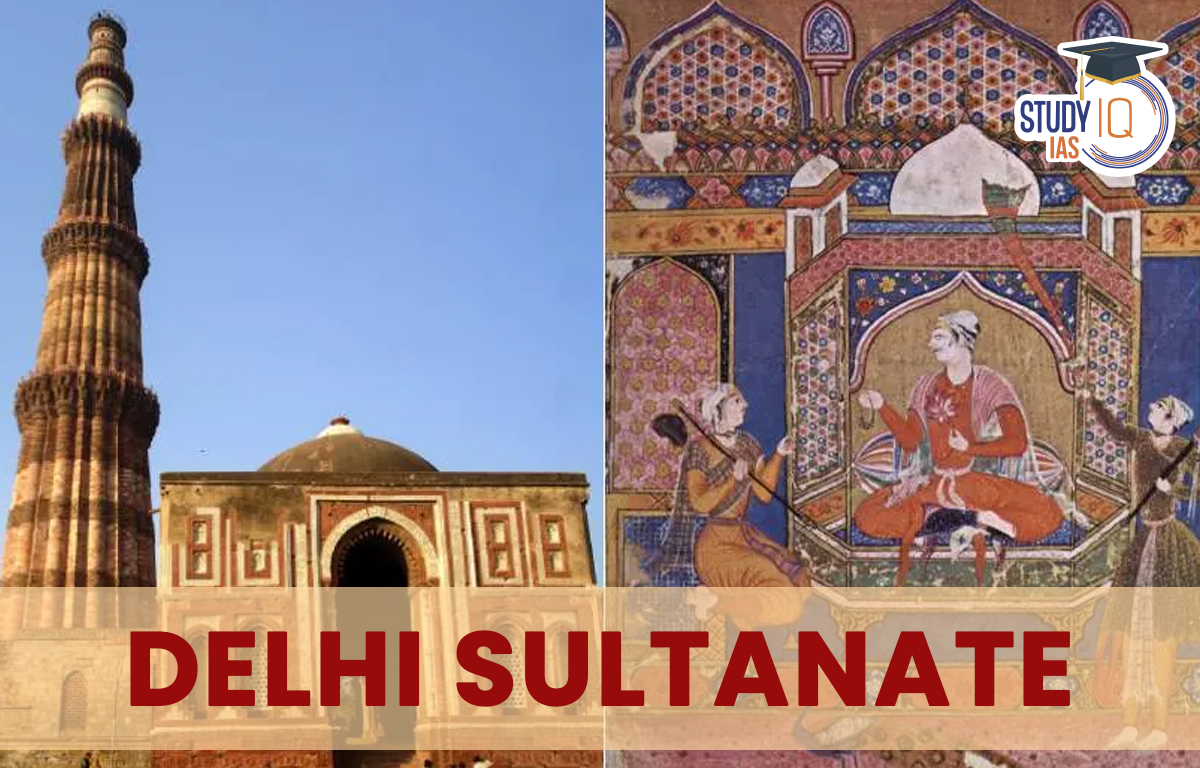Table of Contents
Delhi Sultanate
An Islamic dynasty with its capital in Delhi, the Delhi Sultanate ruled over a sizable portion of the Indian peninsula for 320 years. (1206–1526). The Delhi Sultanate was governed by five dynasties in succession: the Mamluk (1206–1290), Khalji (1290–1320), Tughlaq (1320–1414), Sayyid (1414–1451), and Lodi (1290–1451). It included vast areas of territory in present-day Bangladesh, Pakistan, India, and some southern Nepalese regions. The Delhi Sultanate is an extremely important topic in the History Subject of UPSC Syllabus.
Delhi Sultanate History
From 1206 to 1526, the Delhi Sultanate was an Islamic Empire that ruled over South Asia, mainly the Indian peninsula. It bears the name of Delhi, a former seat of the sultanate and an ancient city in Northern India. According to historians, the Delhi Sultanate was split into five distinct dynastic periods. Five families exist:
- Mamluk Dynasty (1206-1290)
- Khilji Dynasty (1290-1320)
- Tughluq Dynasty (1320-1413)
- Sayyid Dynasty (1414-1451)
- Lodi Dynasty (1451-1526)
Turkic migration, a common practice during the Middle Ages in which Central-Asian ethnic Turks expanded throughout Eurasia and assimilate into the cultures and political systems of powerful nations, is the tale of the founding of the Delhi Sultanate. The Turkic people rarely made the decision to migrate alone.
On occasion, Turks were forced to abandon their nation. Taking slaves from other nations became a prevalent practice in the Middle Eastern Islamic nations of the Middle Ages because it was prohibited to enslave Muslims. A large number of Turks were made into Mamluks, or “slave warriors,” for the Middle Eastern caliphates. It turns out that the first ruler of Delhi was a Mamluk.
Also Read: Muhammad Shah
Delhi Sultanate Founder
An attack marks the beginning of the Delhi Sultanate’s history. The Ghaznavid Dynasty of Islamic Turks began undertaking raids across Northern India in the tenth century, assaulting fortifications and spreading Turkic culture, but they never settled there. A Sultan from the Persian Ghurid Dynasty named Muhammad of Ghor later tried to create a permanent presence in Northern India. Between 1173 and 1206, Mohammed of Ghor moved into Northern India. Despite the fact that his victory led to his death, his ambition persisted.
Under Muhammed of Ghor, Qutb al-Din Aibak, a Mamluk leader, took control of Northern India and officially proclaimed himself the first sultan of Delhi. The loyalty of his soldiers and Aibak’s generosity earned him a good reputation, but historians are still divided over the specifics of how the Mamluks came to govern India.
Either Aibak appointed him prior to his passing in 1206, or Muhammad of Ghor named him before his death in 1206. In any case, Aibak’s rule ended in 1210, and a tumultuous succession dispute followed. Because of Aibak’s Mamluk ruler, the first ruler of the Delhi Sultanate is known as the Mamluk Dynasty.
Delhi Sultanate Rulers
The Delhi Sultanate was a Muslim empire that ruled over parts of India from the 13th century to the 16th century. During this period, several rulers came to power, and some of the most prominent ones are listed below:
Delhi Sultanate Slave Dynasty Rulers
The slave Dynasty stood in for the Turkish race. Most sultans were born during the Delhi Sultanate period.
| Delhi Sultanate Ruler | Time Period | Remarks |
| Qutb-ud-din Aibak | 1206 AD – 1210 AD | Founder of Slave Dynasty |
| Aram Shah | 1210 AD – 1211 AD | Qutb-ud-din Aibak’s eldest son |
| Shams-ud-din Iltutmish | 1211 AD – 1236 AD | Qutb-ud-din Aibak’s Son-in-law |
| Ruknuddin Feruz Shah | 1236 AD | Iltutmish’s son |
| Razia Sultana | 1236 AD – 1240 AD | Iltutmish’s daughter |
| Muizuddin Bahram | 1240 AD – 1242 AD | Iltutmish’s son |
| Alauddin Masud | 1242 AD – 1246 AD | Ruknuddin Feruz Shah’s son |
| Nasiruddin Mahmud | 1246 AD – 1266 AD | Razia’s Brother |
| Kaimur | 1290 AD | Muiz-ud-din Kaiqubad’s son |
Delhi Sultanate Khilji Dynasty Rulers
Below given is the list of the Khilji Dynasty of the Delhi Sultanate:
| Delhi Sultanate Ruler | Time Period | Remarks |
| Jalal-ud-din Firoz Khilji | 1290-1296 | Founder of the Khilji/Khalji Dynasty |
| Alauddin Khilji | 1296-1316 | Jalal-ud-din Firoz Khilji’s nephew |
| Qutb-ud-din Mubarak Shah | 1316-1320 | Son of Alauddin Khilji |
Delhi Sultanate Tughluq Dynasty Rulers
Below given is the list of rulers of the Tughluq Dynasty of the Delhi Sultanate:
| Delhi Sultanate Ruler | Time Period | Remarks |
| Ghiyath al-Din (Ghiyasuddin) Tughluq | 1320-1325 | |
| Muhammad bin Tughluq | 1325-1351 | Also called Muhammad Shah II |
| Mahmud Ibn Muhammad | 1351 (March) | |
| Firoz Shah Tughlaq | 1351-1388 | Muhammad bin Tughlaq’s cousin |
| Ghiyas-ud-Din Tughluq II | 1388-1389 | |
| Abu Bakr Shah | 1389-1390 | |
| Nasir ud din Muhammad Shah III | 1390-1393 | |
| Ala ud-din Sikandar Shah I | 1393 | |
| Mahmud Nasir ud din | 1393-1394 | Also known as Sultan Mahmud II |
| Nasir-ud-din Nusrat Shah Tughluq | 1394-1399 | Firoz Shah Tughlaq’s grandson |
| Nasir ud din Mahmud | 1399-1412 | Mahmud Nasir-ud- din’s |
Also Read: Decline of Mughal Empire
Delhi Sultanate Last Ruler
The Pashtuns of the Lodi Tribe, who were Iranians, controlled the Lodi Dynasty. By the time the Lodi came into control, the Delhi Sultanate had already begun to decline. The headquarters of the Delhi Sultanate was moved by Sultan Sikandar Lodi to the city of Agra, which would go on to grow and prosper after the end of the Delhi Sultanate. Ibrahim Lodi, the son of Sikandar, would serve as the Delhi Sultanate’s final legitimate monarch.
The First Battle of Panipat, 1526 which saw the future Mughal Emperor Babur defeat Ibrahim Lodi and create his own dynasty in India, was the culmination of political tensions that existed during Ibrahim Lodi’s rule.
Delhi Sultanate Innovations
The Delhi Sultanate isn’t well known for any notable mechanical discoveries or advancements. Instead, the creative creation of an Islamic state within a predominantly Hindu region fascinates scholars. Northern India is tough to reach by land because the Himalayan Mountains mostly surround it. Genghis Khan’s Mongol invasion was previously thwarted by geographic obstacles and a warm environment. The invasion of India by Mohammed of Ghor was novel and a resounding triumph.
But when the Ghurid Dynasty’s invasions eventually made it to India, the Islamic faith accompanied them. Hinduism differed from Islam in many fundamental ways, chiefly because Islam was a monotheistic faith as opposed to Hinduism’s polytheistic beliefs. The concept of equality under God was one element of Islam that many Hindu adherents found appealing. Those born at the bottom of society saw a chance in Islam to escape their caste-driven subjugation because the Hindu religion upheld a strict hierarchy with little vertical movement.
Many of the rulers of the Delhi Sultanate were not precisely satisfied with considering Hinduism to be on par with Islam, despite being somewhat tolerant of it. Numerous significant Hindu temples were destroyed during each Delhi Sultanate era, and their stones were occasionally used to build Islamic mosques. Although the destruction of sacred monuments was not particularly novel, historians have been enthralled for years by Islam’s stronghold in Northern India.
Delhi Sultanate Administration
For a while, the Delhi Sultanate is a strong and highly organized state that spanned almost all of India from Delhi to Madurai. The Sultans saw themselves as the Caliph’s ambassadors in Baghdad. (lieutenant of the faithful). The Caliph’s name was written on their coins and included in the khutba, or supplication.
The most significant and supreme political, judicial, and military power was that of the Sultan. He also served as the military’s supreme leader. He was also in charge of preserving justice and the rule of law. During this time, there wasn’t clear succession legislation in place.
Delhi Sultanate Architecture
A large number of churches and Islamic tombs were built throughout Northern India under the control of the Delhi Sultanate. Delhi’s design was characterized by arches and domes. These architectural designs were new in the Indian subcontinent but commonplace in the Middle East. The Qutub Minar, a 73-meter tall minaret structure in Delhi, India, is arguably the most well-known and still-standing example of Delhi Sultanate architecture.
Delhi Sultanate Social Life
The structure of Hindu society didn’t alter all that much during this time. Sati was a commonly practiced custom. For upper-class women, isolation and purdah wear were standard practices. The purdah system was introduced to India by the Arabs and Turks, where it expanded among Hindu women in the upper classes of north India.
The Muslim society stayed split into various ethnic and racial groups throughout the Sultanate period. Muslims from Turkey, Iran, Afghanistan, and India, for example. Between these categories, there were no intermarried couples. Hindu nobility received high positions in the administration very infrequently. Hindus were required to pay a fee known as jiziya because they were regarded as protected or zimmis.
Delhi Sultanate Significance
The Delhi Sultanate had a major impact on Northern India’s development during the late Middle Ages. The Delhi Sultanate saw Northern India’s economy and population thrive as never before as a result of converting large segments of the population to Islam and introducing foreign cultures into the area. Expanding cities, the introduction of Middle Eastern technologies, and improved agricultural methods modernized India, putting it in position for centuries of economic supremacy as the Mughal Empire during the Early Modern Period.
Delhi Sultanate UPSC
From 1206 to 1526, the Delhi Sultanate, an Islamic state in Northern India, was ruled by five distinct dynasties. Qutb al-Din Aibak, a Mamluk and the chief commander of Muhammed of Ghor, the ruler of the Ghurid Dynasty, founded the Delhi Sultanate. By introducing Islam and converting a large portion of the people in the area, the Delhi Sultanate fundamentally altered India. It also built a strong economy that supported the country’s rapid population growth. Candidates can learn more about preparing for the UPSC Exam by visiting the StudyIQ UPSC online Coaching websites.


 Jallianwala Bagh Massacre, Date, History...
Jallianwala Bagh Massacre, Date, History...
 Important Lakes of India, State wise and...
Important Lakes of India, State wise and...
 Buddhism History, Origin, Sect, Councils...
Buddhism History, Origin, Sect, Councils...





















